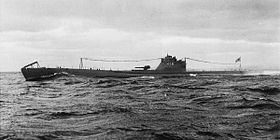Name I-24 Commissioned 31 October 1941 Fate Sunk, 11 June 1943 Construction started 5 December 1938 Length 109 m | Laid down 5 December 1938 Struck 1 August 1943 Class and type Type C1 submarine Launched 12 November 1939 | |
 | ||
The Japanese submarine I-24 was one of five Type C cruiser submarines of the C1 sub-class built for the Imperial Japanese Navy (IJN) during the 1930s.
Contents
Design and description
The Type C submarines were derived from the earlier KD6 sub-class of the Kaidai class with a heavier torpedo armament for long-range attacks. They displaced 2,595 tonnes (2,554 long tons) surfaced and 3,618 tonnes (3,561 long tons) submerged. The submarines were 109.3 meters (358 ft 7 in) long, had a beam of 9.1 meters (29 ft 10 in) and a draft of 5.3 meters (17 ft 5 in). They had a diving depth of 100 meters (330 ft).
For surface running, the boats were powered by two 6,200-brake-horsepower (4,623 kW) diesel engines, each driving one propeller shaft. When submerged each propeller was driven by a 1,000-horsepower (746 kW) electric motor. They could reach 23.6 knots (43.7 km/h; 27.2 mph) on the surface and 8 knots (15 km/h; 9.2 mph) underwater. On the surface, the C1s had a range of 14,000 nautical miles (26,000 km; 16,000 mi) at 16 knots (30 km/h; 18 mph); submerged, they had a range of 60 nmi (110 km; 69 mi) at 3 knots (5.6 km/h; 3.5 mph).
The boats were armed with eight internal bow 53.3 cm (21.0 in) torpedo tubes and carried a total of 20 torpedoes. They were also armed with a single 14 cm (5.5 in) deck gun and two single or twin mounts for 25 mm (1 in) Type 96 anti-aircraft guns. They were equipped to carry one Type A midget submarine aft of the conning tower.
Construction and career
I-24 was commissioned at Sasebo, Japan on 31 October 1941. She participated in the attack on Pearl Harbor as the mother ship of a midget submarine piloted by Ensign Kazuo Sakamaki, who became the first Japanese prisoner of war when his boat washed up on the shore of Oahu some time after the attack. I-24 also took part in the Battle of the Coral Sea and attack on Sydney Harbour in May and June 1942. I-24 was depth-charged, rammed, and sunk with all hands (104 officers and men) by the United States Navy subchaser USS Larchmont (PC-487) at 53°16′N 174°24′E near Shemya, Alaska on 11 June 1943.
